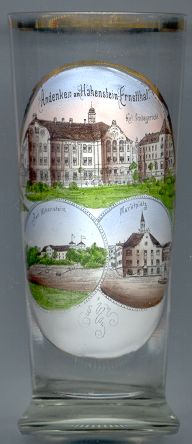

|
| DEUTSCHLAND | GERMANY |
| Bundesland: Freistaat Sachsen | Saxony |
| Landkreis: Zwickau |
 Hohenstein-Ernstthal is situated at an elevation of 356 m at the southern slope of the Pfaffenberg (480 m) at the northern
part of the Erzgebirge mountains in western Saxony.
Hohenstein-Ernstthal is situated at an elevation of 356 m at the southern slope of the Pfaffenberg (480 m) at the northern
part of the Erzgebirge mountains in western Saxony.
When silver has been discovered in this area in 1407, a settlement was founded "uff den hohen stein" ('on the high stone', the Pfaffenberg); the earliest document mentioning this name dates from 1411. The settlement, which was located in a densely wooded area, was destroyed in 1430 by the Hussites and it took until 1473 that the mining activities could be resumed. In 1510 Hohenstein obtained the status of a town from Countess Anna Gratiosa of Schönburg. Mining for silver, copper and arsenic ores, and to a lesser extent even gold, was especially successful around 1600. After the Thirty Years' War (1618–1648) mining was taken up again in 1657. During the times of the plague in the late 17th century, another settlement was founded in the forests east of Hohenstein. At first called Neuhohenstein, then Waldplätze ('places in the woods'), it was finally named Ernstthal in 1687 by Counts Christian and August Ernst of Schönburg. In 1694 Ernstthal obtained the status of a market town. Hohenstein and Ernstthal were united two centuries later, in 1898. All mining activities were finally discontinued in 1910.
The three pictures on glass no. 1772 [left] show
the  Royal
Royal Bad
Bad town
town
The most famous son of Hohenstein-Ernstthal is certainly Karl May who was born at Ernstthal in 1842. He became one of the
most famous authors of adventure stories loacted in the Wild West and in the Orient. Most of his stories were written as
first-person narratives, where the figures of Old Shatterhand and Kara ben Nemsi (i.e. Karl, son of the Germans) were the
alter egos of Karl May. Since 1896 he lived in Radebeul where he died in 1912.
![[scale]](lineal.jpg)